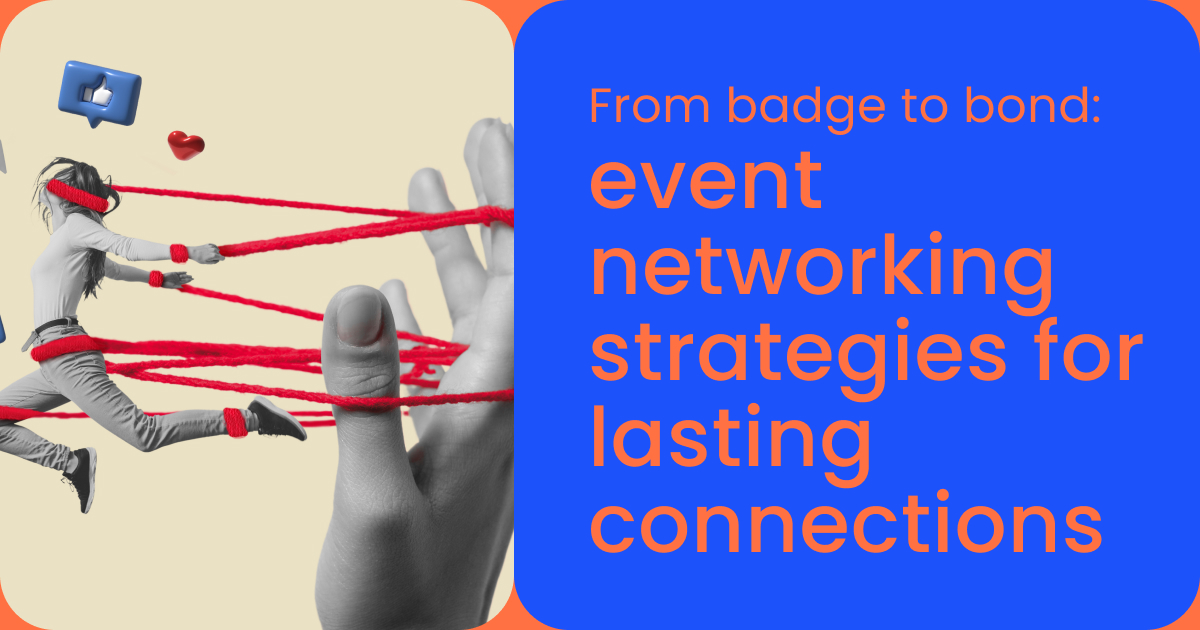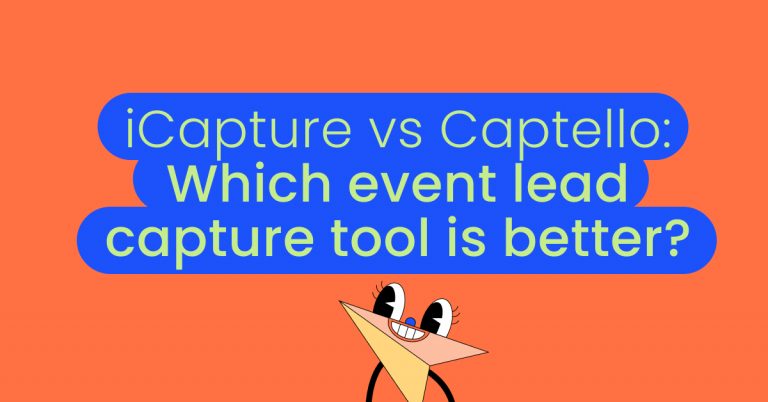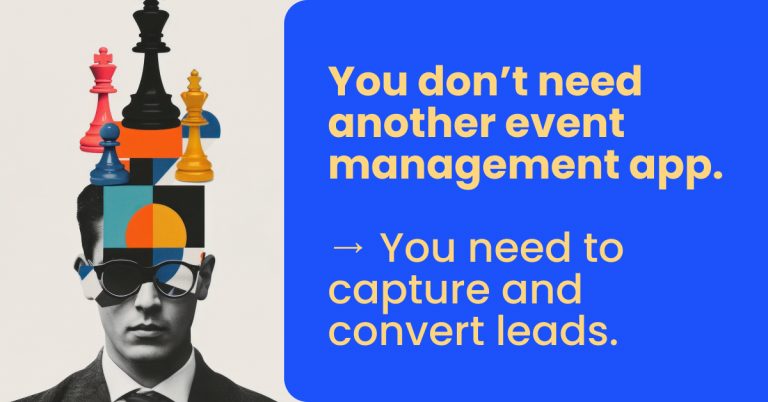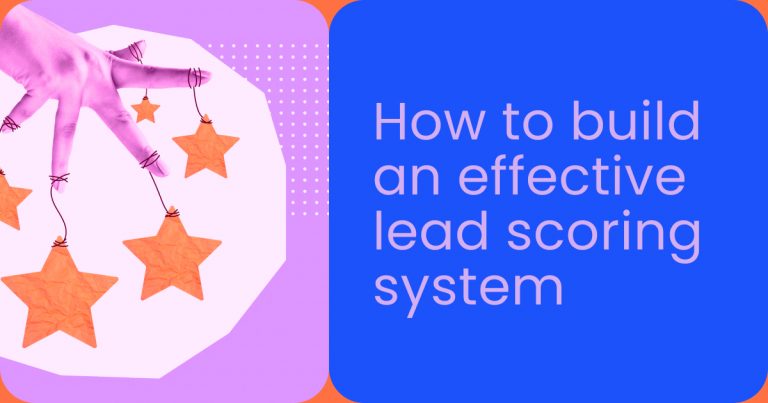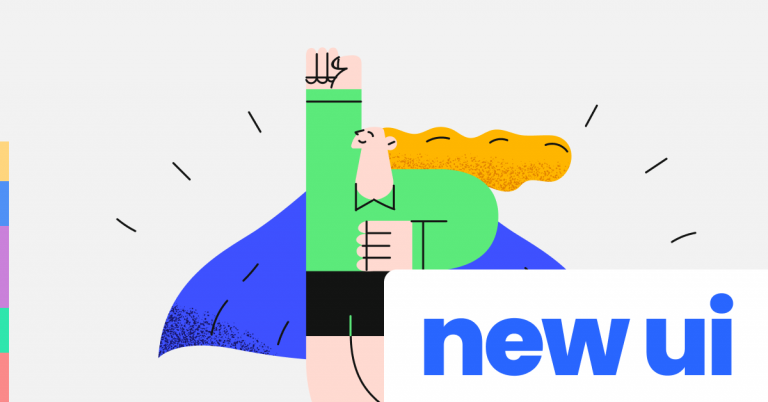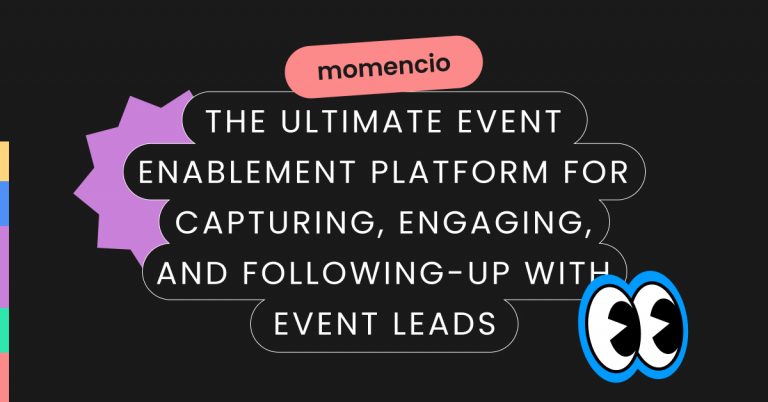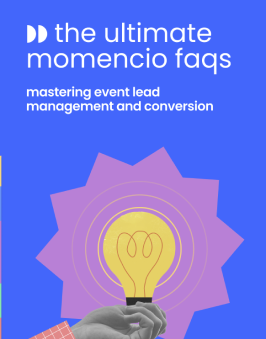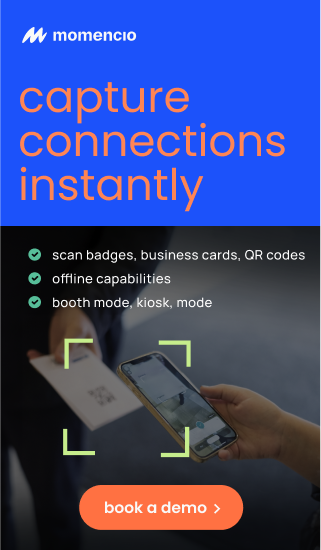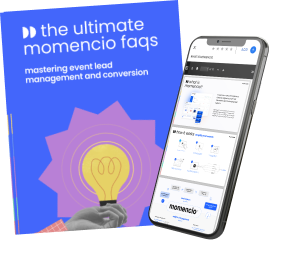TL;DR (Too Long; Didn’t Read)
The big idea
Networking at events isn’t just about collecting business cards. It’s about building lasting relationships. Successful event professionals go beyond the handshake by using strategic networking tactics to connect, engage, and follow up effectively.
Before the event
- Set clear networking goals
- Research key attendees
- Engage with them on social media for warm introductions
During the event
- Use conversation openers that spark genuine interest
- Pay attention to confident body language
- Leverage digital tools like QR codes to create memorable connections
After the event
- Follow up within 48 hours
- Personalize your outreach with specific conversation points
- Nurture relationships using email, LinkedIn, and CRM tools
Technology tip
Use AI-driven matchmaking and CRM integrations to track interactions and enhance your networking success.
Key takeaway
The best event networking strategies are intentional, engaging, and consistent. They lead to long-term professional relationships and meaningful business growth.
Why event networking is more than just a handshake
Most professionals attend events for networking, yet only 38% successfully convert event connections into long-term business relationships. That’s a huge missed opportunity.
According to a report, 95% of professionals say face-to-face connections are crucial for business growth. However, many fail to maximize these interactions — either by not preparing in advance, making weak in-event connections, or neglecting post-event follow-ups.
So, how do you turn a simple badge scan into a meaningful business relationship? How can you ensure that your next networking event isn’t just a series of forgettable handshakes but an opportunity to build lasting connections?
What this guide will help you achieve
Prepare effectively before the event
Meet the right people with clear goals and a focused strategy.
Make an impact during the event
Use smart conversations and digital tools to stand out.
Follow up strategically
Convert connections into partnerships, sales, or collaborations.
By the end of this guide, you’ll have an actionable networking playbook that ensures every event you attend leads to real, long-term business opportunities.
Pre-event networking: laying the groundwork
Successful networking starts before the event. Professionals who plan ahead make the most valuable connections.
Set clear networking goals
Defining networking goals helps maximize event interactions. Ask yourself:
- Are you looking to generate leads?
- Do you want to find potential partners or investors?
- Are you aiming to reconnect with existing contacts?
A goal-oriented approach makes networking more strategic.
Tailor your approach to your goals
- If the priority is lead generation, focus on decision-makers
- If the goal is industry connections, prioritize networking lounges and roundtables
- If scouting for partnerships, research exhibitors and sponsors in advance
According to LinkedIn, professionals who set networking goals before an event are 40% more likely to make meaningful connections.
Research attendees and speakers
Many events provide attendee lists, exhibitor directories, or speaker lineups. Reviewing these helps in:
- Identifying key people to meet
- Creating a target list of high-value contacts
- Reaching out in advance via LinkedIn or email
Sample outreach message
Hi [Name],
I saw that you’ll be attending [Event Name] and would love to connect. I’ve been following your work on [specific topic] and would be interested in learning more about your insights. Let me know if you’d be open to a quick chat during the event.
A pre-event introduction makes in-person meetings more effective.
Engage on social media
Interacting on social media before an event increases visibility.
Tactics to boost visibility
- Follow the event hashtag and engage with posts
- Comment on speakers’ content to start conversations
- Announce your attendance and invite connections to meet
Engaging early establishes familiarity, making in-person interactions easier.
Schedule meetings in advance
Reaching out early ensures time with key contacts.
Ways to book meetings ahead
- Use event networking apps to set appointments
- Book one-on-one meetings with high-priority attendees
- Identify and join relevant networking sessions
Strategic planning prevents missed opportunities and maximizes networking potential.
Post-event follow-up: turning contacts into clients
Meeting valuable contacts at an event is just the beginning. The real challenge lies in nurturing those connections into long-term professional relationships, partnerships, or sales opportunities.
Studies show that 80% of leads require at least five follow-ups before converting, yet nearly 44% of people give up after just one attempt. A structured follow-up strategy ensures that networking efforts translate into real business results.
Follow up within 48 hours to stay top-of-mind
Timeliness is crucial in post-event networking. The 48-hour rule is widely regarded as the ideal follow-up window because:
- The event is still fresh in everyone’s minds, making your outreach more effective
- Decision-makers often receive multiple follow-ups, and reaching out early increases the chance of engagement
- A quick follow-up demonstrates enthusiasm and professionalism
Best practices for the first follow-up
Personalize your message
Avoid generic emails. Reference specific topics discussed during the event.
Keep it concise and actionable
Get to the point quickly. Make it easy for the recipient to respond.
Provide value
Share an article, report, or industry insight related to your discussion to keep the conversation going.
Example of an effective follow-up email
Subject: Great meeting you at [Event Name]!
Hi [First Name],
It was great connecting at [Event Name]. I really enjoyed our conversation about [specific topic], especially your insights on [something they mentioned].
As promised, I wanted to share [a relevant resource, article, or insight]. I’d love to continue our discussion—would you be open to a quick follow-up call next week? Let me know what works for you.
Looking forward to staying in touch!
Best,
[Your Name]
This email achieves four goals:
- References the event to establish context
- Acknowledges the conversation to create a personal touch
- Offers value to keep the recipient engaged
- Includes a clear call-to-action to encourage a response
Segment contacts for personalized engagement
Not all connections require the same follow-up strategy. Segmenting contacts ensures that your outreach is relevant and effective.
High-priority leads (potential clients or business partners)
- Follow up within 24–48 hours
- Offer a direct meeting or next-step discussion
- Send personalized insights or case studies related to their business challenges
Strategic industry connections (thought leaders, influencers, potential collaborators)
- Follow up within 3–5 days
- Engage via LinkedIn and industry conversations
- Share relevant articles, upcoming events, or mutual business opportunities
General connections (casual acquaintances, non-priority contacts)
- Follow up within one week
- Keep the conversation open-ended
- Send a simple note like: Great meeting you at [Event]! Let’s stay in touch.
Using a CRM or event platform like momencio helps automate and organize follow-ups, ensuring that contacts don’t get lost in a crowded inbox.
Leverage LinkedIn for long-term engagement
Email isn’t the only follow-up method. LinkedIn is a powerful tool for maintaining professional relationships beyond a single event.
Best practices for LinkedIn follow-ups
- Send a connection request with a personalized note referencing the event
- Engage with their content by liking or commenting on posts
- Share valuable insights related to your discussion via direct message
- Introduce mutual connections to strengthen networking relationships
Example of a LinkedIn follow-up message
Hi [First Name],
It was great meeting you at [Event Name]! I really enjoyed our conversation about [specific topic]. Let’s connect—I’d love to stay in touch and continue exchanging insights on [industry focus].
Looking forward to keeping in touch!
Maintaining a presence on LinkedIn transforms networking into an ongoing relationship, not just a one-time interaction.
Use automation and CRM tools for structured follow-ups
Manually tracking every event contact can be overwhelming. A structured follow-up system using automation and CRM tools streamlines the process.
How event technology simplifies follow-ups
- Automated email sequences: Platforms like momencio allow users to send personalized follow-up emails immediately after an event
- Lead scoring: AI-powered tools prioritize high-value connections, ensuring the most promising leads receive immediate attention
- Meeting reminders and follow-up scheduling: Integrating follow-ups into a calendar helps prevent missed opportunities
Example of a structured follow-up timeline
- Day 1–2: Personalized email or LinkedIn message
- Day 3–5: Follow-up with additional value (article, industry insight, event recap)
- Week 2: Check-in message to explore deeper conversation
- Week 4: Continue engagement by interacting with their content or sharing relevant updates
By leveraging technology, professionals can ensure that no valuable connection slips through the cracks.
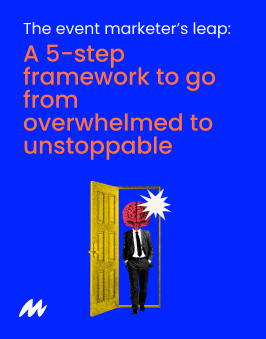
Common networking mistakes to avoid
Event networking is an opportunity to build relationships, establish credibility, and create business opportunities. However, many professionals unintentionally sabotage their efforts by making avoidable mistakes. These missteps often result in lost connections, forgotten conversations, and missed opportunities for long-term collaboration.
Understanding these pitfalls ensures that networking efforts translate into real value rather than wasted time.
Focusing on quantity over quality
A common misconception is that networking success is measured by the number of business cards collected or badges scanned. However, networking is about relationships, not transactions.
Instead of trying to meet as many people as possible, focus on five to ten meaningful conversations per event. Research from the Harvard Business Review suggests that strong professional networks are built on depth, not breadth—meaning a handful of valuable connections is more impactful than dozens of surface-level interactions.
How to fix this mistake
- Spend more time with each person to establish a genuine connection rather than rushing from one introduction to the next
- Take notes on key discussions to personalize follow-ups later. Many event apps, including momencio, allow real-time note-taking on each contact
- After meeting a new connection, repeat their name in conversation and discuss a memorable topic to ensure they remember you as well
Being too transactional
Networking is about building relationships, not making sales pitches. One of the fastest ways to disengage someone is by focusing only on what they can do for you.
Many professionals make the mistake of treating networking like a sales transaction, pushing their product or service before establishing rapport.
How to fix this mistake
- Lead with curiosity. Ask open-ended questions about their work, challenges, and interests before talking about your own
- Provide value before asking for something. If you offer insight, connections, or resources first, people are more likely to engage with you long term
- Frame conversations around collaboration. Instead of saying, “Let me tell you about our product,” ask, “Have you faced challenges with [topic]? I’d love to exchange ideas on how companies are solving that”
According to a LinkedIn study, people are five times more likely to engage in follow-ups when the initial conversation is about mutual interests rather than sales pitches.
Failing to personalize follow-ups
One of the biggest networking mistakes is sending generic follow-up messages like:
Great meeting you at [Event]! Let’s stay in touch.
A vague message makes it difficult for the recipient to remember the conversation, decreasing the likelihood of a response. Personalized follow-ups are 40% more likely to result in meaningful conversations, according to HubSpot data.
How to fix this mistake
- Reference the specific conversation. Mention a topic, insight, or shared interest that stood out
- Provide value. Share a relevant article, report, or introduction based on your discussion
- Be clear on the next step. If you want to set up a call or meeting, make a direct request with a proposed time frame
Example of a weak follow-up email
Hey [Name], great meeting you at [Event]! Hope we can stay connected.
Example of a strong follow-up email
Subject: Continuing our conversation on [topic] from [Event]
Hi [Name],
I really enjoyed our discussion at [Event], especially your insights on [specific topic]. I came across this article on [related subject] and thought you might find it interesting.
Would you be open to a quick follow-up call next week to continue the conversation? Let me know what works for you.
Looking forward to staying in touch.
Best,
[Your Name]
This approach reminds the recipient of your discussion, provides immediate value, and sets up the next step for engagement.
Waiting too long to follow up
Another major mistake is delaying follow-ups until weeks after an event, by which time the connection has faded.
The best time to follow up is within 24–48 hours after the event. According to research by Sales Hacker, follow-up emails sent within 48 hours have a 50% higher response rate than those sent after a week.
How to fix this mistake
- Block time in your calendar immediately after an event to send follow-ups
- Use CRM tools like momencio to automate follow-ups, ensuring no contact is forgotten
- Prioritize high-value connections first, then work through general contacts
Not maintaining long-term engagement
Many professionals assume networking ends once the event is over. In reality, staying visible and engaged over time is what turns contacts into business opportunities.
A single conversation isn’t enough to solidify a professional relationship. Without consistent engagement, most connections fade within three months, according to a LinkedIn networking study.
How to fix this mistake
- Engage on LinkedIn: Comment on their posts, share relevant content, or send occasional messages to check in
- Invite them to webinars or industry discussions: Keeping them involved strengthens the relationship
- Send periodic updates: If you discussed an ongoing topic, send follow-ups with insights, case studies, or relevant news
Example of a long-term engagement message
Hi [Name], I saw your recent post about [topic]—really insightful! I’d love to hear your thoughts on [related trend]. Hope all is well!
Consistently nurturing relationships increases the likelihood of future collaborations, partnerships, and business referrals.
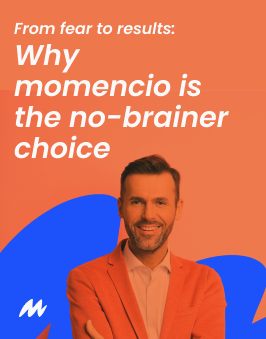
Leveraging technology for smarter networking
Technology has transformed the way professionals connect at events. Traditional networking methods—exchanging business cards, manually tracking contacts, and relying on memory for follow-ups—are inefficient in today’s fast-paced business environment.
Event technology solutions, powered by AI, CRM systems, and mobile networking tools, help professionals maximize their connections and convert them into long-term business opportunities.
AI-powered matchmaking and networking tools
Many modern events integrate AI-powered networking platforms that help attendees connect with the most relevant professionals based on shared interests, industries, and goals. These tools use data-driven insights to recommend high-value connections, making networking more strategic and efficient.
How AI matchmaking enhances networking
- Smart recommendations: AI analyzes attendee profiles, previous event behavior, and stated preferences to suggest relevant connections
- Automated scheduling: AI-driven platforms help attendees book meetings in advance, ensuring meaningful conversations happen during the event
- Conversation prompts: AI tools generate talking points based on mutual interests, making introductions smoother and more engaging
Events using AI-powered networking tools see a 35% increase in successful post-event connections compared to those relying on manual networking.
Digital business cards and contact exchange solutions
Traditional business cards are becoming obsolete. Studies show that 88% of business cards are discarded within a week, making digital alternatives more effective.
Why digital business cards are better
- Instant contact exchange: Digital cards allow attendees to share contact details with a single scan or click
- Real-time updates: Unlike printed cards, digital profiles remain up to date with no reprinting costs
- Integration with CRM tools: Many digital card solutions sync with CRM systems, making follow-ups seamless
CRM integration for effective follow-ups
Capturing contact information is just the first step—what happens after the event is what truly matters. A CRM system helps event professionals manage, segment, and nurture connections efficiently.
How CRM integration improves event networking
- Automated follow-ups: Schedule and personalize follow-ups within 24–48 hours after the event
- Lead scoring and prioritization: Identify the most promising contacts based on engagement levels
- Tracking interactions: Monitor which contacts engage with emails, content, or event follow-ups
Best CRM solutions for event networking
- HubSpot CRM: Provides automated follow-up workflows and lead tracking
- Salesforce: Integrates event data with sales pipelines for seamless lead nurturing
- momencio: Captures and scores event leads, tracks engagement, and automates follow-ups
Research from HubSpot shows that companies using CRM-integrated event follow-ups experience a 42% higher conversion rate compared to those relying on manual outreach.
The power of real-time event analytics
Event technology platforms now provide real-time analytics that help professionals measure networking effectiveness.
Key event networking metrics to track
- Number of new contacts added: Measures how many meaningful connections were made
- Engagement rate: Tracks how many follow-up emails or messages receive responses
- Conversion rate: Evaluates how many event leads turn into business opportunities
How to use event analytics for smarter networking
- Identify high-value interactions: Track which conversations or connections are leading to post-event engagement
- Refine networking strategies: Analyze which sessions, lounges, or activities generated the most valuable contacts
- Optimize follow-up timing: Use data to determine the best time to reconnect with contacts
Events that utilize real-time analytics see a 28% increase in post-event engagement, according to an Event Industry Trends report.
Conclusion
The most successful professionals understand that networking is an ongoing process that requires strategy, follow-up, and long-term engagement.
By implementing pre-event preparation, in-event engagement tactics, structured follow-ups, and leveraging technology, event attendees can turn short conversations into valuable business opportunities.
Key takeaways for smarter event networking
- Prepare before the event: Set clear networking goals, research key attendees, and use event apps to schedule meetings
- Engage effectively during the event: Focus on quality over quantity, ask insightful questions, and use digital tools for seamless contact exchange
- Follow up strategically: Send personalized messages within 48 hours, segment contacts based on priority, and provide value in every interaction
- Use technology to your advantage: AI-powered matchmaking, digital business cards, and CRM integration help automate and optimize networking
- Maintain long-term engagement: Stay visible on LinkedIn, nurture relationships with useful insights, and periodically check in with key contacts
Effective networking doesn’t stop at the event—it’s about leveraging the right tools to maintain and grow relationships. That’s where momencio can help.
With momencio, professionals can:
- Capture and score leads in real time using badge scanning and AI-powered engagement tracking
- Automate personalized follow-ups so no valuable connection is lost
- Sync contacts with CRM systems for seamless lead nurturing and long-term engagement
- Analyze post-event engagement metrics to refine networking strategies for future events
Want to maximize your event connections and turn networking into business success?
Book a demo with momencio today and see how technology can enhance your networking strategy.
FAQs
- What are the best ways to break the ice at an event?
- Rather than using generic introductions, start with insightful questions that open the door to meaningful conversation. You can ask what inspired someone to attend the event, what challenges they’re currently facing in their industry, or which session or speaker they’ve found most valuable so far. These types of questions go beyond small talk and lead to deeper, more memorable interactions.
- How can introverts be successful at networking?
- Introverts often excel in smaller, more intentional settings. To make networking more comfortable, focus on one-on-one meetings or small-group discussions. You can also engage with attendees on LinkedIn before the event to establish familiarity. Using event apps to schedule meetings in advance provides a structure that reduces the pressure of spontaneous conversations.
- What’s the ideal way to follow up after an event?
- The best time to follow up is within 24 to 48 hours while the event is still fresh in both parties’ minds. Personalize your message by referencing something you discussed during the event and offer value in your follow-up, such as sharing an article, resource, or a relevant connection.
- Should I connect with everyone I meet on LinkedIn?
- Not necessarily. It’s better to connect only with professionals where there’s a genuine reason to continue the relationship. When sending a connection request, always include a short personalized note that references your conversation at the event to remind them of your interaction and why staying in touch would be meaningful.
- What’s the best way to measure networking success?
- Success in networking isn’t just about the number of contacts collected. It’s better measured through outcomes such as how many people responded to your follow-ups, the number of meetings or calls scheduled after the event, any new business opportunities that arise, and how actively your new contacts engage with you on platforms like LinkedIn. Ultimately, long-term engagement is a more valuable indicator than volume alone.
Interesting facts from research
- Networking follow-through remains a challenge: According to Forbes, 80% of professionals believe networking is essential for career success. However, only 38% consistently follow up after events, highlighting a major gap between intent and action.
- AI-driven events lead to stronger connections: Events incorporating AI-powered matchmaking experience a 35% increase in meaningful post-event connections compared to traditional networking formats.
- Traditional business cards are becoming obsolete: Salesforce reports that 88% of business cards are discarded within a week, making digital contact exchange tools significantly more effective for lasting connections.
- CRM integration boosts conversion rates: Data from HubSpot reveals that companies using CRM-integrated event follow-ups see a 42% higher conversion rate than those relying on manual outreach, reinforcing the importance of tech-enabled networking strategies.
